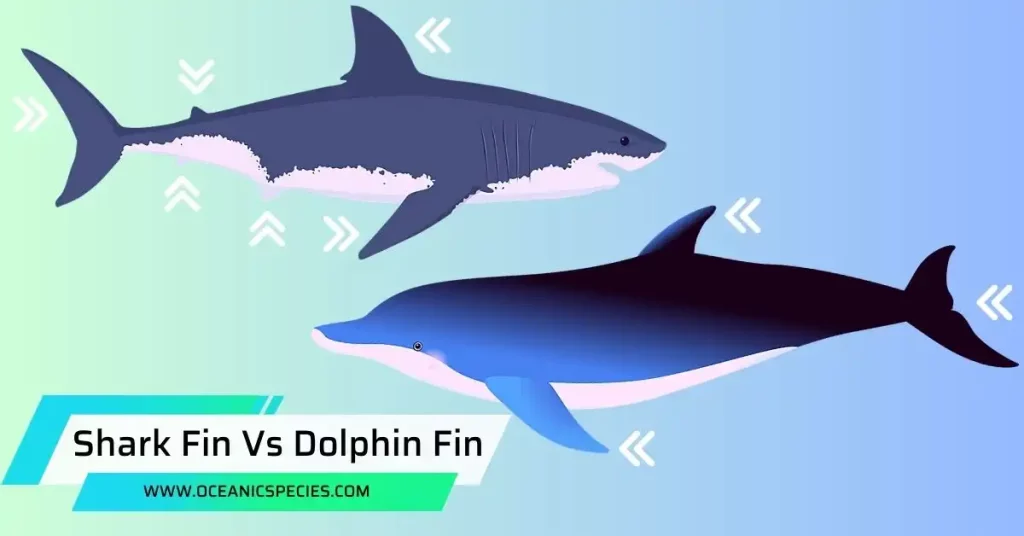Shark fin and dolphin fin differ in shape and purpose. Shark fins are rigid and angular, designed for stability and propulsion, while dolphin fins are curved and flexible, aiding in maneuverability and communication.
Sharks are renowned for their distinct dorsal fins, which protrude vertically from their backs. These fins provide stability and prevent the shark from rolling while swimming. The shape and size of the dorsal fin can vary between species, with some sharks having tall, triangular fins for better maneuverability, while others have smaller, more streamlined fins for faster swimming speeds. Additionally, the dorsal fin can also serve as a visual display, used by sharks to assert dominance or communicate with other individuals.
On the other hand, dolphins possess a curved dorsal fin that is located near the middle of their backs. This fin is flexible and allows dolphins to make quick and precise movements when swimming. Besides aiding in maneuverability, the dolphin’s dorsal fin also plays a vital role in communication. Dolphins use their fins to display various behaviors, such as slapping the water’s surface or leaping out of the water, which can convey messages to other dolphins in the vicinity.
While both shark and dolphin fins are essential for their respective species, they differ in shape and purpose. Shark fins provide stability and propulsion, whereas dolphin fins aid in maneuverability and communication. Understanding these distinctions helps us appreciate the diverse adaptations found in marine life and the crucial role fins play in their survival.
The Anatomy Of Shark And Dolphin Fins
While shark fins provide stability, lift, and efficient propulsion, dolphin fins offer enhanced agility, maneuverability, and precision movement. Let’s delve deeper into the structure, characteristics, and functions of these fins to uncover the key differences between sharks and dolphins.
Overview Of Shark Fin Structure

The fins of sharks are distinct and well-adapted to their environment. Shark fins are primarily composed of cartilage, a flexible and lightweight tissue that assists in swift movement through the water.
Sharks possess different types of fins, including dorsal fins, pectoral fins, pelvic fins, and caudal fins (tail fins).The dorsal fin is situated on the shark’s back and provides stability and maneuverability. It varies in size and shape across different shark species.
Pectoral fins, located on either side of the shark’s body, are responsible for lift, balance, and steering while swimming. Pelvic fins are positioned on the ventral side of the shark and aid in maintaining stability during swimming. The caudal fin, commonly known as the tail fin, propels the shark forward and generates significant thrust.
Explanation Of Shark Fin Characteristics And Function
Shark fins possess unique characteristics that enable these creatures to excel in their marine habitat. The shape of shark fins varies greatly between species. Some fins are triangular, while others are more crescent-shaped or rounded. This diversity influences their swimming capabilities and agility.
The degree of flexibility in shark fins allows for efficient movement, rapid changes in direction, and quick acceleration. This feature is crucial during hunting and evading predators. Different shark species have fins with varying degrees of stiffness. This stiffness aids in preventing excessive bending or deformation while swimming, ensuring effective propulsion through the water.
Sharks’ dorsal fins act as hydrodynamic stabilizers, reducing body roll and maintaining equilibrium while swimming. The location and size of the dorsal fin impact the shark’s overall agility and maneuverability.
Comparison To Dolphin Fin Structure And Function

While shark fins possess prominent features, dolphin fins display their own unique adaptations. Let’s compare the structure and function of dolphin fins to gain a better understanding:
- Dolphin fins share some similarities with shark fins, such as consisting primarily of cartilage, providing flexibility and reducing weight.
- However, dolphin fins differ in shape and placement. Their dorsal fin is curved, taller, and more centrally positioned, allowing for enhanced stability and streamlined movement.
- Dolphin pectoral fins, unlike shark pectoral fins, are elongated, resembling wings. These fins aid in steering, diving, and balancing, enabling dolphins to navigate with remarkable agility.
- The caudal fin of dolphins, also known as the fluke, is horizontal and broad, facilitating powerful swimming strokes and swift propulsion.
- Dolphin fins have a greater range of motion compared to shark fins, as dolphins are known for their acrobatic leaps, flips, and spins.
The Power And Speed Of Shark Fins
Sharks are renowned for their strength and agility in the water, with their fins playing a crucial role in enabling their efficient swimming and maneuvering. Let’s dive into the fascinating world of shark fins and explore the predatory advantages they offer.
Diving Into The Strength And Agility Of Shark Fins
Shark fins are not just ordinary fins; they are marvels of evolution designed to help these majestic creatures navigate their environments with incredible skill and precision. Here are some key points about the strength and agility of shark fins:
- Streamlined shape: The unique shape of shark fins, tapering to a point, reduces drag in the water, allowing sharks to swiftly glide through the ocean.
- Stiff and rigid: Shark fins consist of a cartilaginous structure that provides strength and rigidity. This allows for powerful and efficient propulsion through the water.
- Multiple fins: Sharks possess several types of fins, including the dorsal fin, pectoral fins, and caudal fin (or tail fin). Each fin serves a specific purpose in maintaining balance, stability, and control during swimming.
- Dynamic movements: Sharks can flex and adjust their fins, enabling them to make sudden turns, accelerate rapidly, and navigate tight spaces with ease. The ability to control their fins adds to their superb maneuverability.
How Shark Fins Enable Efficient Swimming And Maneuvering
Shark fins are not just aesthetically pleasing; they serve a crucial role in enabling sharks to swim efficiently and maneuver effectively. Here are some key points highlighting their advantage:
- Hydrodynamic efficiency: The shape and placement of shark fins minimize water resistance, allowing them to swim faster and use less energy compared to animals with less efficient fins.
- Lift and stabilization: The pectoral fins, located on the sides of a shark’s body, provide lift and balance. Alongside the help of the tail fin, they help stabilize the shark while swimming by countering the body’s rolling motion.
- Propulsion and acceleration: The combined movement of the caudal fin, also known as the tail fin, and the body’s muscular contractions creates a strong propulsion force. This enables sharks to swiftly accelerate and pursue prey or evade predators.
- Enhanced turning ability: Sharks can rapidly change direction by manipulating their pectoral fins and using their tail fin as a rudder. This agility gives them a significant advantage when hunting or avoiding potential threats.
The Intelligence And Adaptability Of Dolphin Fins
Dolphins’ incredible cognitive abilities enable them to harness the potential of their fins for navigation, communication, and adaptability in the vast oceanic environment.
Exploring The Cognitive Abilities Of Dolphins
Dolphins are renowned for their high level of intelligence. Their cognitive abilities are on par with those of humans and some primates. Dolphins have large brains relative to their body size, which is indicative of their intelligence. They exhibit self-awareness, as proven by their ability to recognize themselves in mirrors and solve complex problems.
Dolphins possess a remarkable capacity for emotional expression and empathy, often demonstrating empathy towards injured or distressed individuals. Studies reveal that dolphins possess a sophisticated vocal communication system, where they use distinct whistles and clicks to communicate with each other. They also have the ability to understand and respond to human commands, showcasing their impressive cognitive flexibility.
How Dolphin Fins Aid In Oceanic Navigation And Communication
Dolphin fins serve more than just locomotion; they play a crucial role in their oceanic navigation and communication. Dolphin fins are ideal for maneuvering through different water currents and depths, offering precise control and propulsion. These fins also contribute to their remarkable speed, as dolphins can reach speeds of up to 35 miles per hour.
The shape and structure of dolphin fins allow them to gracefully glide through the water, reducing drag and maximizing efficiency. Fins enable dolphins to expertly navigate complex marine environments, aiding in their ability to locate food sources and avoid potential threats. Dolphin fins, combined with their well-developed sensory systems, facilitate effective communication within their pod through non-verbal cues, body language, and vocalizations.
Adaptive Features That Make Dolphin Fins Versatile
Dolphin fins possess a range of adaptive features that make them incredibly versatile in the diverse marine ecosystem. The flexible nature of dolphin fins allows for efficient turning, accelerating, and sudden changes in direction.
The presence of fatty tissues in the fins helps with buoyancy control, allowing dolphins to effortlessly dive to different depths. The dorsal fin, located on their back, aids in stability and balance while swimming and jumping. The pectoral fins, positioned on the sides of their bodies, enable precise maneuvers, such as gliding laterally. The muscular structure of dolphin fins allows them to withstand strong currents, ensuring optimal control and agility.
Shark Fin Vs. Dolphin Fin: Strength And Speed
Sharks and dolphins are both magnificent creatures of the oceans, each equipped with fins that help propel them through the water. But when it comes to strength and speed, which one reigns supreme? Let’s compare the power and speed capabilities of shark and dolphin fins and explore the specific adaptations that contribute to their respective abilities.
Comparing The Power And Speed Capabilities Of Shark And Dolphin Fins
Shark fins:
- Streamlined and rigid, shark fins are designed for stability and maneuverability in the water.
- Filled with a dense network of collagen fibers, shark fins provide excellent structural support.
- The unique shape and placement of shark fins minimize drag and turbulence, allowing them to swim quickly and efficiently through the water.
- Some shark species, such as the great white shark, have large, powerful pectoral fins that generate significant thrust, enabling bursts of speed when hunting prey.
- The muscular caudal fin, or tail fin, of sharks acts as a powerful propeller, propelling them forward with remarkable force.
Dolphin fins:
- Dolphin fins, known as flippers, are elongated and flexible, giving them a sleek and sleek appearance.
- Made up of a combination of bones, muscles, and connective tissue, dolphin fins are highly maneuverable and versatile.
- The curvature and flexibility of dolphin fins allow for quick changes in direction and swift acceleration, making them incredibly agile swimmers.
- Dolphins possess a dorsal fin, located on their backs, which assists in maintaining balance while navigating the water.
- The caudal fin, or tail fluke, of dolphins is horizontal and acts as a powerful paddle, generating propulsive thrust and enabling them to swim swiftly.
Examining Specific Adaptations That Contribute To Their Respective Abilities
Shark fin adaptations:
- Dorsal fins of sharks help stabilize their bodies while swimming and prevent rolling movements.
- The upper lobe of the caudal fin, known as the heterocercal tail, creates lift and allows sharks to swim efficiently at various depths.
- The presence of dermal denticles on shark fins reduces drag and promotes smooth movement through the water.
- Some shark species have enlarged pectoral fins with strong muscles to aid in acceleration and cruising speeds.
Dolphin fin adaptations:
- The flexibility of dolphin fins allows them to adjust the shape and angle, enabling optimal hydrodynamics.
- The fluke of dolphin tails is broad and muscular, enabling powerful propulsion and quick bursts of speed.
- The dorsal fin of dolphins can vary in size and shape, contributing to stabilization and balance control during swift movements.
- The presence of blubber beneath the skin helps maintain body temperature and provides buoyancy for the dolphin’s fins.
Implications For Survival And Hunting Strategies
The unique adaptations of shark and dolphin fins greatly influence their survival and hunting strategies.
Sharks:
- The strength and speed of shark fins enable them to chase down prey, swiftly maneuver through the water, and quickly escape potential dangers.
- The streamlined shape and powerful tail allow sharks to navigate different ocean depths efficiently.
- Sharks often rely on their incredible burst of speed to surprise and capture prey, using their sharp teeth and powerful jaws to secure a meal.
Dolphins:
- The agility and swiftness of dolphin fins enable them to travel long distances in search of food, evade predators, and engage in social interactions.
- Dolphin pods work together to corral and capture their prey, deploying their fins and bodies strategically to create waves and herd fish for easy feeding opportunities.
- The adaptability of dolphin fins allows for precise control and graceful movements, showcasing their playful and intelligent nature.
Shark Fin Vs. Dolphin Fin: Agility And Maneuverability
While both shark and dolphin fins contribute to their respective species’ swimming abilities, dolphin fins are generally more flexible and adaptable, allowing for greater agility and maneuverability. The unique design of each fin type serves specific purposes, enabling sharks and dolphins to thrive in their marine environments.
Analyzing The Agility And Maneuvering Capabilities Of Shark And Dolphin Fins
Shark fins:
- Shark fins are vertical and rigid, allowing for stability and forward propulsion.
- Their large size and broad surface area provide lift, helping sharks maintain buoyancy.
- The shape of shark fins varies across species, with some having more pointed tips for better maneuverability.
- Shark fins are primarily designed for straight-line swimming and cruising through the water.
- Due to their inflexibility, sharks rely more on their body movements rather than their fins for sharp turns and quick changes in direction.
Dolphin fins:
- Dolphin fins, also known as flukes, are horizontal and flexible, allowing for enhanced agility and maneuverability.
- The sleek and streamlined shape of dolphin fins minimizes drag, enabling them to swim swiftly through the water.
- The muscles and tendons in dolphin fins provide the necessary power and flexibility for intricate movements.
- Dolphins are capable of making tight turns by using their flukes to generate lift and control their direction.
- Their ability to rapidly change course comes from the dorsal fin acting as a stabilizer, enabling them to maintain balance during quick maneuvers.
How Each Fin Type Enables Swift Turns And Quick Direction Changes
Shark fins:
- Shark fins are designed to be robust and rigid, providing stability and power for straight-line swimming.
- While not as agile as dolphin fins, shark fins aid in making gradual turns by using their body movements.
- Their large size and broad surface area also contribute to maintaining stability during quick changes in direction.
Dolphin fins:
- The horizontal orientation and flexibility of dolphin fins allow for quick and precise movements.
- Dolphin fins can generate lift and act as rudders, helping them make swift turns.
- The muscles and tendons in dolphin fins provide the necessary strength and control for rapid changes in direction.
- Dolphins can also use their pectoral fins for additional maneuverability when navigating through tight spaces.
Applications In Hunting, Evading Predators, And Social Interactions
Shark fins:
- The rigid and powerful nature of shark fins enables efficient cruising, allowing sharks to cover large distances in search of prey.
- Sharks use their fins to maintain steady movements while stalking and pursuing their prey.
- While they may not have the same level of agility as dolphins, shark fins are still effective in evading predators through sudden bursts of speed.
Dolphin fins:
- The agility and maneuverability provided by dolphin fins are crucial for hunting and capturing prey.
- Dolphins can effortlessly change directions and speed, making them effective hunters in pursuit of fast-swimming fish.
- The precise control offered by their fins enables dolphins to navigate complex aquatic environments and coral reefs with ease.
- In social interactions, dolphin fins play a role in displaying dominance, communication, and coordination within groups.
The Evolutionary Advantages Of Shark And Dolphin Fins
Fins are critical adaptations that have allowed sharks and dolphins to thrive in their marine environments. Both sharks and dolphins belong to the same branch of the evolutionary tree, known as the ‘chondrichthyes’. The ancestors of sharks and dolphins were fish-like creatures that inhabited the earth’s oceans over 290 million years ago.
Highlighting key adaptations that have shaped their fin structures:
Sharks have pectoral, pelvic, and dorsal fins, each serving a specific purpose: Pectoral fins aid in stability and maneuverability, enabling sharks to make sharp turns and sudden movements. Pelvic fins primarily assist in balance and control during swimming. Dorsal fins provide critical stability, preventing rolling motions.
Dolphins possess two types of fins: The pectoral fins of dolphins, often referred to as flippers, are elongated and act as the primary source of propulsion. The dorsal fin of dolphins, located on their backs, provides stability and balance while swimming.
How these adaptations have contributed to their respective success:
Sharks have remained virtually unchanged over millions of years due to their highly effective fin adaptations: The streamlined shape of shark fins reduces drag and allows for efficient movement through the water. The various fin combinations grant sharks incredible agility and the ability to effortlessly navigate through complex environments. These adaptations, coupled with their keen sensory systems, have cemented sharks as efficient predators and enduring species.
Dolphins, with their unique fin structures, have achieved their own evolutionary success: The elongated and flexible pectoral fins of dolphins enable them to reach impressive speeds by generating strong propulsion. The dorsal fin provides an advantage in maintaining balance and precise maneuvering while hunting or navigating through ocean currents. These adaptations, combined with their high intelligence and highly social behavior, have allowed dolphins to thrive as agile and intelligent marine mammals.
Frequently Asked Questions
Are Shark Fins And Dolphin Fins Similar In Structure?
Yes, shark fins and dolphin fins have different structures. Shark fins are stiff while dolphin fins are flexible.
Do Sharks And Dolphins Use Their Fins For The Same Purpose?
No, sharks use their fins primarily for stability and maneuverability, while dolphins use their fins for propulsion and steering.
Are Shark Fins And Dolphin Fins Made Of The Same Material?
No, shark fins are made of cartilage, while dolphin fins are made of dense connective tissue.
Can Dolphins Swim Faster Than Sharks Due To Their Fins?
Yes, dolphins are generally faster swimmers than sharks due to their streamlined bodies and powerful fins.
Are There Any Similarities Between Shark Fins And Dolphin Fins?
While there are some similarities in their overall shape, shark fins and dolphin fins serve different purposes and have distinct structures.
Conclusion
When comparing shark fins and dolphin fins, it is evident that both play crucial roles in their respective ecosystems. While shark fins are known for their use in the controversial shark finning industry, it is important to recognize that dolphins, with their sleek and versatile fins, contribute greatly to the balance and harmony of ocean life.
Dolphin fins enable efficient swimming, communication, and hunting techniques, allowing them to thrive in their marine habitats. On the other hand, shark fins provide stability, agility, and buoyancy, enabling these apex predators to maintain their dominance in the food chain.
As we continue to understand the intricate web of life in the ocean, it becomes clear that every species, and the unique features they possess, are essential for maintaining the delicate balance of our marine ecosystems.





